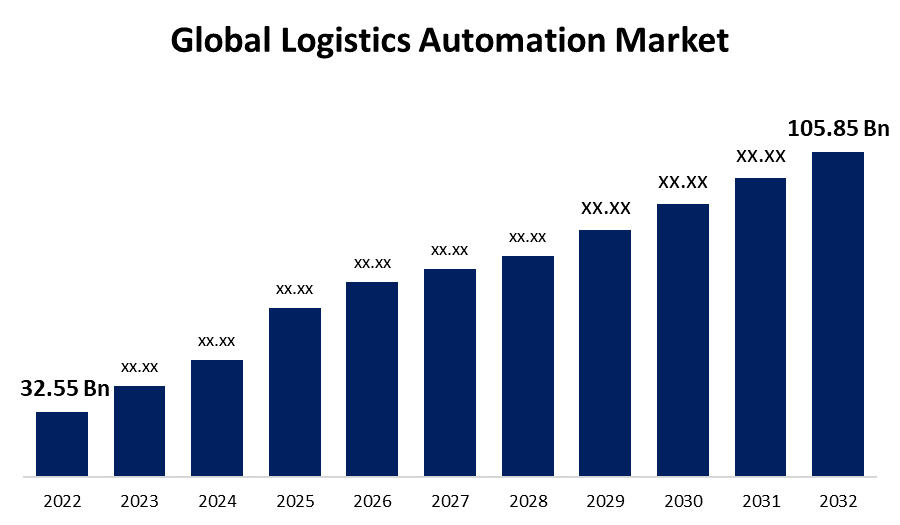Global Logistics Automation Market Size to Exceed USD 105.85 Billion By 2032 | CAGR of 12.5%
Category: Information & TechnologyGlobal Logistics Automation Market Size to Exceed USD 105.85 Billion by 2032
According to a research report published by Spherical Insights & Consulting, the Global Logistics Automation Market Size is to Grow from USD 32.55 Billion in 2022 to USD 105.85 Billion by 2032, at a Compound Annual Growth Rate (CAGR) of 12.5% during the projected period. Automation in logistics includes the use of machinery, control systems, and software to improve operational efficiency. It usually refers to activities carried out in a warehouse or distribution center that require little human intervention.

Get more details on this report -
Browse key industry insights spread across 200 pages with 100 market data tables and figures & charts from the report on "Global Logistics Automation Market Size, Share, and COVID-19 Impact Analysis, By Component (Hardware, Software, Services), By Function (Transportation Management, Warehouse Management, Inventory & Storage, Others), By Logistics Type (Sales Logistics, Production Logistics, Recovery Logistics, Others), By Enterprise Size (Large Enterprises, SMEs), By Software Application (Inventory Management, Order Management, Yard Management, Shipping Management, Labor Management, Vendor Management, Customer Support, Others), By End-User (Retail & E-commerce, Healthcare, Automotive, Aerospace & Defense, Electronics & Semiconductors, Others) and By Region (North America, Europe, Asia-Pacific, Latin America, Middle East, and Africa), Analysis and Forecast 2022 – 2032." Get Detailed Report Description Here: https://www.sphericalinsights.com/reports/logistics-automation-market
Increased customer service, scalability, speed, organizational control, and mistake minimization are some of the benefits of logistics automation. The expansion of the e-commerce industry, as well as global demand for effective warehousing and inventory management, are driving the market. Logistics automation systems can be a valuable addition to the services offered by these more sophisticated computer systems. When a single node within a larger logistics network is the focus, solutions may be customized to meet its specific needs. Robots are being utilized more frequently to improve logistics operations. In recent years, logistics robots have grown in popularity. Because of the rising complexity of warehousing and the necessity for flexible and efficient operations, companies have invested in automated storage and retrieval systems (AS/RS) to automate movements and different regions within the facility. The growth of logistics robots is a reaction to the desire to reduce costs and streamline processes in order to increase competitiveness. There is a lack of consistency in governance principles. In order to boost revenue and viability, logistics organizations are focusing on increasing supply chain efficiency. The logistics industry needs common governance rules. Universal logistics management standardization makes it easier and more efficient for any provider to supply the majority of solutions in a single bundle.
COVID-19 Impact
The COVID-19 pandemic has resulted in labor adjustments, temporary restrictions on product transportation, and the deployment of automation solutions. The pandemic has caused supply-chain disruptions, causing temporary restrictions on product transport. The increase in online sales has driven businesses to redesign their warehouses in order to manage e-commerce logistics. At the same time, businesses have had to protect the health and safety of the people who work throughout the supply chain. To meet e-commerce demand and adapt to new factors, some logistics organizations implemented staff adjustments and opted for logistics automation.
The software segment dominates the market with the largest revenue share over the forecast period.
On the basis of components, the global logistics automation market is segmented into hardware, software, and services. Among these, the software segment is dominating the market with the largest revenue share over the forecast period. Warehouse management systems and transportation management systems are two subsets of the software market. The warehouse management software automates and optimizes various kinds of warehouse processes such as tracking, inventory storage, receiving, and workload planning, and is expected to have the largest market share over the projected period.
The inventory & storage segment is witnessing significant CAGR growth over the forecast period.
On the basis of function, the global logistics automation market is segmented into transportation management, warehouse management, inventory & storage, and others. Among these, the inventory & storage segment is witnessing significant CAGR growth over the forecast period. Inventory and storage management needs the use of automated storage and retrieval technologies. Autonomous storage systems automate the storage of crates or pallets on racks or shelves, whereas retrieval systems automate the retrieval of products from warehouses for dispatch. The automation of the inventory and storage process simplifies and accelerates product tracking and tracing in a large warehouse.
The production logistics segment is expected to hold the rapid revenue growth of the global Logistics Automation market during the forecast period.
Based on the logistics type, the global logistics automation market is classified into sales logistics, production logistics, recovery logistics, and others. Among these, the production logistics segment is expected to grow at a rapid pace during the forecast period. In order to maximize profitability, businesses place a high priority on optimizing manufacturing processes, including time and cost efficiency. Logistics is one of the most expensive aspects of running a business, and automation can help to reduce or at least optimize expenses. Raw material inventory management, transit within the manufacturing unit, and distribution are all aspects of production logistics.
The small & medium enterprises (SMEs) segment is projected to grow at the highest CAGR in the market during the forecast period.
On the basis of enterprise size, the global logistics automation market is segmented into large enterprises and SMEs. Among these, the small & medium enterprises (SMEs) segment grow at highest CAGR growth over the forecast period. Small and medium-sized enterprises prioritize cost-cutting measures such as automation to reduce labor costs. A lot of companies are growing in the e-commerce fulfillment service market, and fulfillment centers are increasingly utilizing automated sorting systems for fulfillment procedures such as kitting and packaging. Because of automation, small and medium-sized firms can compete with large corporations.
The inventory management segment is projected to grow at the highest CAGR in the market during the forecast period.
On the basis of software application, the global logistics automation market is segmented into inventory management, order management, yard management, shipping management, labor management, vendor management, customer support, and others. Among these, the inventory management segment grows at highest CAGR growth over the forecast period. Inventory management includes maintaining track of inventory levels, controlling inventories for each product, anticipating demand, and accounting for overall inventory. Inventory management is critical for a successful organization because both excess and low inventory can be harmful to a company's profitability.
The healthcare segment is projected to grow at the highest CAGR in the market during the forecast period.
On the basis of end-users, the global logistics automation market is segmented into retail & e-commerce, healthcare, automotive, aerospace & defense, electronics & semiconductors, and others. Among these, the healthcare segment grows at highest CAGR growth over the forecast period. Healthcare logistics automation systems handle, store, and retrieve healthcare products such as vaccinations and medicines in a safe and secure manner. To ensure product safety, the healthcare business requires a high level of accuracy and accountability, and automation is helpful in this regard.
North America dominates the market with the largest market share of more than 33.3% over the forecast period.

Get more details on this report -
North America is dominating the market over the forecast period. The presence in North America of many logistics’ automation solution providers and logistics giants such as UPS, DHL, and FedEx Corporation, among others, has contributed to the region's growth. Furthermore, the quick implementation of current technology and the presence of modern infrastructure in the region help to the growth of the target market. The United States is projected to maintain its dominance during the forecast period due to the country's significant growth in the e-commerce sector. During the projected period, the Asia-Pacific market is expected to grow the fastest. The Asia Pacific region is expected to have tremendous economic growth, notably in e-commerce. Furthermore, Asia Pacific includes countries such as Singapore, Indonesia, China, and India which operate as logistical centers.
Major vendors in the Global Logistics Automation Market include Dematic Corp. (Kion Group AG), Daifuku Co. Limited, Swisslog Holding AG (KUKA AG), Honeywell International Inc., Jungheinrich AG, Murata Machinery Ltd, Knapp AG, TGW Logistics Group GmbH, Kardex Group, Mecalux SA, Beumer Group GmbH & Co. KG, SSI Schaefer AG, Vanderlande Industries BV, WITRON Logistik, Oracle Corporation, One Network Enterprises Inc., SAP SE, and among others.
Key Target Audience
- Market Players
- Investors
- End-users
- Government Authorities
- Consulting And Research Firm
- Venture capitalists
- Value-Added Resellers (VARs)
Recent Developments
- In January 2023, Jungheinrich purchased the Indiana-based Storage systems group (Storage Solutions), a prominent provider of racking and warehouse automation systems in the United States, in order to obtain more access to the warehousing and automation markets in the United States.
Market Segment
This study forecasts revenue at global, regional, and country levels from 2022 to 2032. Spherical Insights has segmented the global logistics automation market based on the below-mentioned segments:
Logistics Automation Market, Component Analysis
- Hardware
- Software
- Services
Logistics Automation Market, Function Analysis
- Transportation Management
- Warehouse Management
- Inventory & Storage
- Others
Logistics Automation Market, Logistics Type Analysis
- Sales Logistics
- Production Logistics
- Recovery Logistics
- Others
Logistics Automation Market, Enterprise Size Analysis
- Large Enterprises
- SMEs
Logistics Automation Market, Software Applications Analysis
- Inventory Management
- Order Management
- Yard Management
- Shipping Management
- Labor Management
- Vendor Management
- Customer Support
- Others
Logistics Automation Market, End-Users Analysis
- Retail & E-commerce
- Healthcare
- Automotive
- Aerospace & Defense
- Electronics & Semiconductors
- Others
Logistics Automation Market, Regional Analysis
- North America
- US
- Canada
- Mexico
- Europe
- Germany
- Uk
- France
- Italy
- Spain
- Russia
- Rest of Europe
- Asia Pacific
- China
- Japan
- India
- South Korea
- Australia
- Rest of Asia Pacific
- South America
- Brazil
- Argentina
- Rest of South America
- Middle East & Africa
- UAE
- Saudi Arabia
- Qatar
- South Africa
- Rest of the Middle East & Africa
About the Spherical Insights & Consulting
Spherical Insights & Consulting is a market research and consulting firm which provides actionable market research study, quantitative forecasting and trends analysis provides forward-looking insight especially designed for decision makers and aids ROI.
Which is catering to different industry such as financial sectors, industrial sectors, government organizations, universities, non-profits and corporations. The company's mission is to work with businesses to achieve business objectives and maintain strategic improvements.
CONTACT US:
For More Information on Your Target Market, Please Contact Us Below:
Phone: +1 303 800 4326 (the U.S.)
Phone: +91 90289 24100 (APAC)
Email: inquiry@sphericalinsights.com, sales@sphericalinsights.com
Contact Us: https://www.sphericalinsights.com/contact-us
Need help to buy this report?